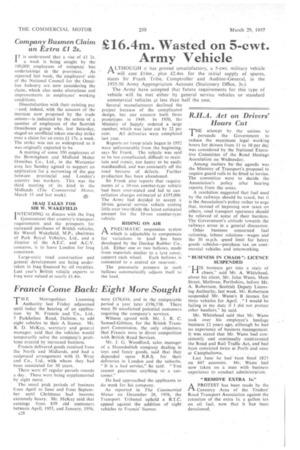£16.4m. Wasted on 5-cwt.
Page 30

If you've noticed an error in this article please click here to report it so we can fix it.
Army Vehicle
ALTHOUGH it has proved unsatisfactory, a 5-cwt. military vehicle will cost £14m., plus £2.4m. for the initial supply of spares, states Sir Frank Tribe, Comptroller and Auditor-General, in the
1955-56 Army Appropriation Account (Stationery Office, 3s.).
The Army have accepted that future requirements for this type of vehicle will be met either by general service vehicles or standard commercial vehicles at less than half the cost.
Several manufacturers declined the project because of the complicated design, but one concern built three prototypes in 1949. In 1950, the Ministry of Supply ordered a large number, which was later cut by 22 per
cent. All deliveries were completed last year.
Reports on troop trials begun in 1952 were unfavourable from the beginning, says Sir Frank. The vehicle was said to be too complicated, difficult to maintain and repair, too heavy to be easily manhandled, and was constantly off the road because of defects. Further production has been abandoned.
Sir Frank also reports that requirements of a 10-ton combat-type vehicle had been over-stated and led to cancellation charges estimated at £195,000 The Army had decided to accept a 10-ton general service vehicle costing little over two-thirds the latest estimated amount for the 10-ton combat-type vehicle.
RIDING ON AIR
APNEUMATIC suspension system which is adjustable to compensate for variations in load has been developed by the Dunlop Rubber Co.. Ltd. Either one or two bellows, made from materials similar to a tyre cover,
support each wheel. Each bellows is connected to a central air reservoir.
The pneumatic pressure in each bellows automatically adjusts itself to the load.




























































































